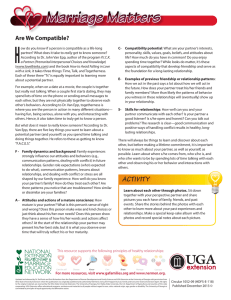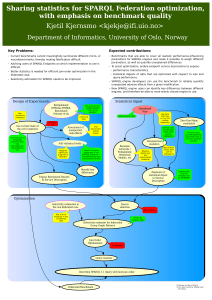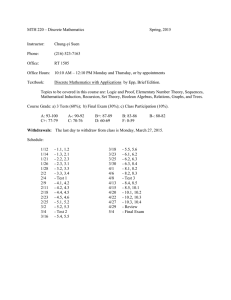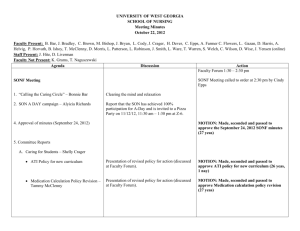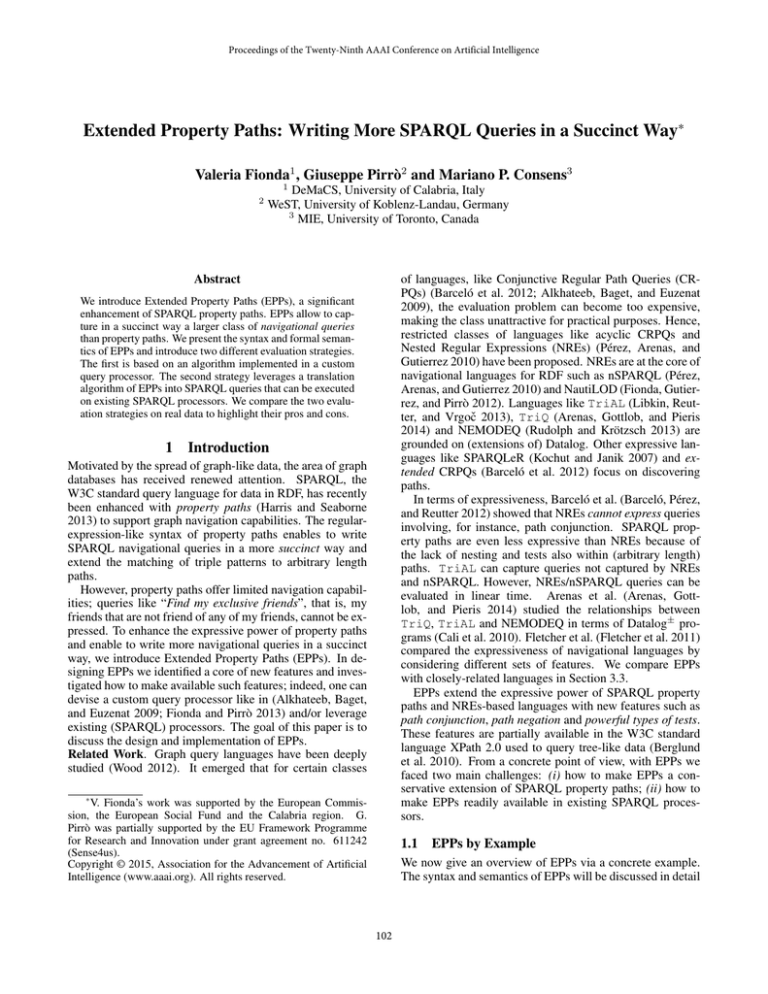
Proceedings of the Twenty-Ninth AAAI Conference on Artificial Intelligence
Extended Property Paths: Writing More SPARQL Queries in a Succinct Way*
Valeria Fionda1 , Giuseppe Pirrò2 and Mariano P. Consens3
1
2
DeMaCS, University of Calabria, Italy
WeST, University of Koblenz-Landau, Germany
3
MIE, University of Toronto, Canada
Abstract
of languages, like Conjunctive Regular Path Queries (CRPQs) (Barceló et al. 2012; Alkhateeb, Baget, and Euzenat
2009), the evaluation problem can become too expensive,
making the class unattractive for practical purposes. Hence,
restricted classes of languages like acyclic CRPQs and
Nested Regular Expressions (NREs) (Pérez, Arenas, and
Gutierrez 2010) have been proposed. NREs are at the core of
navigational languages for RDF such as nSPARQL (Pérez,
Arenas, and Gutierrez 2010) and NautiLOD (Fionda, Gutierrez, and Pirrò 2012). Languages like TriAL (Libkin, Reutter, and Vrgoč 2013), TriQ (Arenas, Gottlob, and Pieris
2014) and NEMODEQ (Rudolph and Krötzsch 2013) are
grounded on (extensions of) Datalog. Other expressive languages like SPARQLeR (Kochut and Janik 2007) and extended CRPQs (Barceló et al. 2012) focus on discovering
paths.
In terms of expressiveness, Barceló et al. (Barceló, Pérez,
and Reutter 2012) showed that NREs cannot express queries
involving, for instance, path conjunction. SPARQL property paths are even less expressive than NREs because of
the lack of nesting and tests also within (arbitrary length)
paths. TriAL can capture queries not captured by NREs
and nSPARQL. However, NREs/nSPARQL queries can be
evaluated in linear time. Arenas et al. (Arenas, Gottlob, and Pieris 2014) studied the relationships between
TriQ, TriAL and NEMODEQ in terms of Datalog± programs (Cali et al. 2010). Fletcher et al. (Fletcher et al. 2011)
compared the expressiveness of navigational languages by
considering different sets of features. We compare EPPs
with closely-related languages in Section 3.3.
EPPs extend the expressive power of SPARQL property
paths and NREs-based languages with new features such as
path conjunction, path negation and powerful types of tests.
These features are partially available in the W3C standard
language XPath 2.0 used to query tree-like data (Berglund
et al. 2010). From a concrete point of view, with EPPs we
faced two main challenges: (i) how to make EPPs a conservative extension of SPARQL property paths; (ii) how to
make EPPs readily available in existing SPARQL processors.
We introduce Extended Property Paths (EPPs), a significant
enhancement of SPARQL property paths. EPPs allow to capture in a succinct way a larger class of navigational queries
than property paths. We present the syntax and formal semantics of EPPs and introduce two different evaluation strategies.
The first is based on an algorithm implemented in a custom
query processor. The second strategy leverages a translation
algorithm of EPPs into SPARQL queries that can be executed
on existing SPARQL processors. We compare the two evaluation strategies on real data to highlight their pros and cons.
1
Introduction
Motivated by the spread of graph-like data, the area of graph
databases has received renewed attention. SPARQL, the
W3C standard query language for data in RDF, has recently
been enhanced with property paths (Harris and Seaborne
2013) to support graph navigation capabilities. The regularexpression-like syntax of property paths enables to write
SPARQL navigational queries in a more succinct way and
extend the matching of triple patterns to arbitrary length
paths.
However, property paths offer limited navigation capabilities; queries like “Find my exclusive friends”, that is, my
friends that are not friend of any of my friends, cannot be expressed. To enhance the expressive power of property paths
and enable to write more navigational queries in a succinct
way, we introduce Extended Property Paths (EPPs). In designing EPPs we identified a core of new features and investigated how to make available such features; indeed, one can
devise a custom query processor like in (Alkhateeb, Baget,
and Euzenat 2009; Fionda and Pirrò 2013) and/or leverage
existing (SPARQL) processors. The goal of this paper is to
discuss the design and implementation of EPPs.
Related Work. Graph query languages have been deeply
studied (Wood 2012). It emerged that for certain classes
* V. Fionda’s work was supported by the European Commission, the European Social Fund and the Calabria region. G.
Pirrò was partially supported by the EU Framework Programme
for Research and Innovation under grant agreement no. 611242
(Sense4us).
Copyright © 2015, Association for the Advancement of Artificial
Intelligence (www.aaai.org). All rights reserved.
1.1
EPPs by Example
We now give an overview of EPPs via a concrete example.
The syntax and semantics of EPPs will be discussed in detail
102
ex: <http://www.example.com/>
rdfs: <http://www.w3.org/2000/01/rdf-schema#>
ex:n7
ex:n2
rdfs:
subPropertyOf
ex:p2
ex:p1
ex:p7
ex:p5
ex:n0
6
ex:n3
3
ex:p5
ex:p10
ex:p5
ex:p10
ex:p10
ex:p5
ex:n4
ex:n6
ex:p10
ex:p10
ex:p6
automatically generated by the translation. The advantage
of the translation is that the query in Fig. 2 can be executed
on existing SPARQL processors. From the syntactic point
of view, the advantage of using EPPs to write navigational
queries instead of writing them directly into pure SPARQL
is that the same request can be expressed more succinctly
and without the need to deal with intermediate variables.
ex:p6
..... ex:p5
.....
ex:p6
8
5
ex:p6
ex:p5
ex:p10
ex:n5
ex:p5
ex:p10
ex:n9
SELECT DISTINCT ?x ?y WHERE {
{ ?x p5 ?y. ?x p10 ?y. }
MINUS
{ ?x p5 ?y.
FILTER EXISTS
{ ?y p6 ?o_0_0_1_0_1_0.
FILTER( ?o_0_0_1_0_1_0 < 6 ) }}}
Figure 1: An example of RDF graph.
in Section 2.
Example 1 (Extended Property Paths). By considering
the graph in Fig. 1, find pairs of nodes1 (ni , nj ) simultaneously connected via two paths: one labeled as p5 and the
other labeled as p10 ; moreover, from nj an edge labeled as
p6 that leads to nodes having value <6 must not exists.
NREs-based languages (and PPs) cannot express such request due to the lack of path conjunction/negation. With
EPPs it can be expressed as:
Figure 2: Translation into SPARQL of Example 1.
1.2
?x ((p5 &p10 )∼(p5 &&TP( o, p6 &&T( o<6)))) ?y
The path conjunction & enables to check that both paths p5
and p10 connect ni with nj , while path negation ∼ enables
to discard from the set of nodes satisfying the first path those
that also satisfy the second one. Note also that SPARQL
property paths and NREs-based languages lack tests like TP,
to check the existence of a path (via p6 ) to nodes having
value <6.
The evaluation of the EPP expression with the algorithm
described in Section 3 starts from all the bindings of the variable ?x; we discuss the case ?x→n0 . From n0 , the evaluation of the first path (p5 &p10 ) enables to reach n3 . The
second path (negated via ∼) is evaluated again from n0 and
consists in the logical AND (via &&) of two tests. The first
test checks for the existence of an edge p5 , which leads to
n3 . The second test (i.e., TP) includes: (i) the position in
the RDF triple from which the test starts; (ii) a path. The
position symbol o means that the test starts from the object of the previous navigational step, that is, the object of
the triple (n0 , p5 , n3 ). From n3 , another logical AND
of two tests is evaluated. The first one checks the existence
of an edge p6 and enables to reach the node 6. The second
AND , which starts from the object of the previous step (i.e.,
6), checks that the value is <6; in this case the test fails and
n3 is not included in the results of the negated path. Conversely, n4 satisfies the test, it is included in the results of the
negated path and thus, it is not a valid binding for ?y when
considering ?x→n0 .
Overall, for ?x→ n0 we get ?y→ n3 meaning that from
n0 the navigation of the graph according to the expression
enabled to reach n3 .
We have also devised a translation procedure (see Section 3.2) of EPPs into SPARQL. The translation of Example 1 is shown in Fig. 2; here, ?o 0 0 1 0 1 0 is a variable
1
Contributions and Organization
The contributions of this paper are the following: (i) EPPs a
language more expressive than NREs-based languages and
SPARQL property paths; (ii) a concise syntax and a formal
semantics for EPPs (iii) an algorithm for the evaluation of
EPPs and an implementation in a custom query processor;
(iv) a formalization and implementation of a translation procedure of EPPs into SPARQL; (v) a comparison between the
custom query processor and Jena ARQ (for EPPs translated
into SPARQL).
EPPs can be seen as a language per se, which goes beyond NREs-based languages and SPARQL property paths.
Moreover, EPPs serve also the purpose of capturing a larger
fragment of pure SPARQL navigational queries in a succinct way. To the best of our knowledge, EPPs are the first
proposal covering both aspects.
The remainder of the paper is organized as follows. Section 2 presents EPPs; syntax and semantics. Section 3 introduces an evaluation algorithm for EPPs and the translation
of EPPs into SPARQL. The implementation and evaluation
of EPPs are discussed in Section 4. We conclude in Section 5.
2
Extended Property Paths
Let U (URIs), B (blank nodes), L (literals), and V (variables, starting withe the ’?’ symbol) be four pairwise disjoint, countably infinite sets. An RDF triple is a tuple of the
form hs, p, oi ∈ (U∪B)×U×(U∪B∪L). An RDF graph G
is a set of triples. We indicate by nodes(G) ⊆ U ∪ B ∪ L the
set of URIs, blank nodes and literals that appear as subject
or object of some triples in G. Moreover, T ⊆ U ∪ B ∪ L is
the set of terms of G.
2.1
Extended Property Paths Syntax
The syntax of EPPs is reported in Table 1.
Commonalities with SPARQL property paths (PPs)
The first line of the syntax covers the syntax of
PPs (Harris and Seaborne 2013) (section 9.1); moreover,
(Negated)PropertySets like ‘!(u1 ||...ˆun ’‘)’ that are
The prefix ex: is omitted for sake of space.
103
epp ::=
test ::=
base ::=
EBuiltInCall ::=
pos ::=
‘ˆ’ epp | epp ‘+’ | epp ‘?’ | epp‘∗’ | epp ‘/’ epp | epp ‘|’ epp | ‘(’ epp ‘)’ |
[pos]1 test [pos]2 | epp ‘&’ epp | epp ‘∼’ epp
‘!’ test | test ‘&&’ test | test ‘||’ test | ‘(’ test ‘)’ | base
uri | ‘TP(’pos ‘,’ epp ‘)’ | ‘T(’EExp‘)’
BuiltInCall | pos
‘ s’ | ‘ p’ | ‘ o’
Table 1: Syntax of EPPs expressions. 1 If omitted is s; 2 If omitted is o.
R1
R2
EJˆeppKG
EJepp1 /epp2 KG
:=
n
:=
n
EJ(epp)∗ KG
EJ(epp)+ KG
EJ(epp)?KG
:=
:=
:=
R6
EJ(epp1 |epp2 )KG
:=
R7
G
R3
R4
R5
R8
R9
R10
R11
R12
R13
R14
R15
EJ(epp1 &epp2 )K
EJ(epp1 ∼ epp2 )KG
EJpos1 test pos2 KG
ET JuKG
t
ET JT(EExp)KG
t
G
ET JTP(pos, epp) Kt
ET Jtest1 &&test2 KG
t
ET Jtest1 ||test2 KG
t
ET J!test KG
t
(u, v) : (v, u) ∈ EJeppKG
o
o
(u, v) : ∃w (u, w) ∈ EJepp1 KG ∧ (w, v) ∈ EJepp2 KG
S
G
{(u, u) | u ∈ nodes(G)} ∪ ∞
i=1 EJeppi K | epp1 = epp ∧ eppi = eppi−1 /epp
S∞
G
i=1 EJeppi K | epp1 = epp ∧ eppi = eppi−1 /epp
{(u, u) | u ∈ nodes(G)} ∪ EJeppKG
n
o
(u, v) : (u, v) ∈ EJepp1 KG ∨ (u, v) ∈ EJepp2 KG
:=
n
:=
n
:=
n
:=
:=
:=
:=
:=
:=
Pm ( p, t) = u
EvalSPARQLBuilt-in(EExp, t)
∃v : (Pm (pos, t), v) ∈ EJeppKG
G
ET Jtest1 KG
t ∧ ET Jtest2 Kt
G
ET Jtest1 KG
∨
E
Jtest
K
2
T
t
t
G
¬ET Jtest Kt
(u, v) : (u, v) ∈ EJepp1 KG ∧ (u, v) ∈ EJepp2 KG
(u, v) : (u, v) ∈ EJepp1 KG ∧ (u, v) ∈
/ EJepp2 KG
o
o
(Pm (pos1 , t), Pm (pos2 , t))) | triple t ∈ G ∧ ET JtestKG
t
o
Table 2: Formal semantics of EPPs expressions.
tions are constructed using elements of the set U ∪ L and
constants, logical connectives (¬, ∧, ∨), (in)equality symbol(s) (=,<,>,≤,≥), unary (e.g., isURI,) and binary (e.g.,
STRSTARTS) functions.
a combination of forward/reverse predicates in a (negated)
set are expressible in the EPPs syntax via the productions
test → base → u. Note that EPPs use the symbol ‘||’
while PPs use ‘|’.
New features introduced by Extended Property Paths
The following additional features are introduced: path conjunction (epp1 &epp2 ), path negation (epp1 ∼epp2 ) and
different types of tests (test) within a path, also by specifying the starting and ending positions (pos). EPPs enable
to test from each of the subject, predicate and object positions in RDF triples, mapped in the syntax to s, p and o,
respectively. Positions do not need to be always specified;
by default a test starts from the subject ( s) and ends on the
object ( o) of a triple.
Tests (test) can be of different types and can be combined by using the logical operators AND (&&), OR (||) and
NOT (!). A test can be a simple check for the existence of
a URI or a nested EPP, i.e., TP(pos, epp), which corresponds to the evaluation of epp starting from a position pos
(of the last triple traversed) and whose evaluation returns
true if, and only if, there exists at least one node that can be
reached via epp. A base test (production base) can be of
type T, which is a SPARQL boolean expression; here, EExp
(not reported here for sake of space) extends the production
[110] in the SPARQL grammar2 where BuiltInCall3
is substituted with EBuiltInCall , which enables to
use in EPPs tests available in SPARQL as built-in conditions also augmented with positions (pos). Built-in condi2
3
2.2
Extended Property Paths Semantics
The semantics (shown in Table 2) for the interpretation of
an EPP expression epp on a graph G uses two functions: (i)
EJeppKG defined as a binary relation (u, v) such that u and
v are nodes in G and v is reachable from u via a path in G
satisfying epp; and (ii) ET Jtest KGt defined as a boolean
function, which evaluates true if, and only if, the triple t
satisfies the test test. The semantics also uses the position
mapping function Pm defined as follows:
Definition 2 (Position mapping function).
Let
t=hx, y, zi be a triple pattern, {x, y, z} ⊆ T ∪ V.
The position mapping function Pm (pos, t) is defined as:
(i) Pm ( s, t) = x, (ii) Pm ( p, t) = y (iii) Pm ( o, t) = z.
Pm selects one among the subject, predicate and object of
a triple on the basis of the value of pos. Consider the
triple hu1 ,p1 ,u2 i and the test T( p=p1 ); this instantiates
Pm as Pm ( p, hu1 ,p1 ,u2 i)=p1 , which checks p1 =p1 returning true while testing T( o=u3 ) gives false.
3
Algorithms and Complexity
This section presents two strategies for the evaluation of
EPPs expressions. The first via an ad-hoc algorithm; the
second one via a translation into SPARQL queries that can
be executed on existing processors.
http://www.w3.org/TR/sparql11-query/\#rExpression
http://www.w3.org/TR/sparql11-query/\#rBuiltInCall
104
Function E VALUATE n, epp, G)
Input: node n, expression epp, graph G; Output: node set Res.
1:
2:
3:
4:
5:
6:
and ‘∗’ ) then it is given as input to the function BASE, which
considers the various forms of syntactic expressions. For
recursive expressions the algorithm uses the function CLO SURE . Finally, the boolean function E VALT EST handles the
different types of test.
The result of the evaluation of an EPP expression epp
from a node n is a set of pairs of nodes (n,nr ) where nodes
nr are reachable from n via paths satisfying epp.
if epp = (epp1 )∗ then
return C LOSURE(n, epp1 , G, {}, 0)
else if epp = (epp1 )+ then
return C LOSURE(n, epp1 , G, {}, 1)
else
return BASE(n, epp, G))
Function C LOSURE n, epp, G, Res, l)
Input: node n, EPPs expression epp, graph G, node set Res, lower bound l;
Output: node set Res.
1: if l = 1 then
2:
S = E VALUATE(n, epp, G)
3: else
4:
S = {n}
5: while S 6= ∅ do
6:
n = extractN ode(S) /* extract one node */
7:
if n ∈
/ Res then
8:
Res = Res ∪ {n}
9:
S = S ∪ E VALUATE(n, epp, G)
10: return Res
We now discuss the complexity of the algorithm. We assume G to be stored by its adjacency list. In particular, for
each t ∈ T , a Hashtable is maintained where the set of keys
is the set of predicates p such that there exists a triple in G
having as subject t and as predicate p, and the set of values
are lists of objects o reachable by traversing p-predicates
from t. We assume that given t and a predicate p the set
of nodes reachable can be accessed in time O(1). An additional Hashtable is used for inverse navigation, that is, for
navigation starting on the object and ending on the subject.
Both structures use space O(|G|). Let |epp| be the size of
the EPP expression epp.
Function BASE n, epp, G)
Input: node n, EPPs expression epp, graph G; Output: node set Res.
Theorem 3 Given the EPP expression epp, an RDF graph
G and a node n ∈ G the evaluation of EJeppKG can be
performed in time O(|G| · |epp|) + cEExp .
1: if epp = epp1 |epp2 then
2: return E VALUATE(n, epp1 , G) ∪ E VALUATE(n, epp2 , G)
3: if epp = epp1 /epp2 then
4: Res0 := E VALUATE(n, epp1 , G)
5: Res = {}
6: for all nodes n0 ∈ Res0 do
7:
Res = Res ∪ E VALUATE(n0 , epp2 , G)
8: return Res
9: if epp = epp1 &epp2 then
10: return E VALUATE(n, epp1 , G) ∩ E VALUATE(n, epp2 , G)
11: if epp = epp1 ∼ epp2 then
12: return E VALUATE(n, epp1 , G) \ E VALUATE(n, epp2 , G)
13: if epp = epp1 ? then
14: return {n} ∪ E VALUATE(n, epp1 , G)
15: if epp = pos1 testpos2 then
16: Res = {}
17: for all triple t ∈ G s.t. Pm (pos1 , t) = n do
18:
if E VALT EST(t, test, G) then
19:
Res = Res ∪ {Pm (pos1 , t), Pm (pos2 , t)}
20: return Res
Proof: [S KETCH] The function E VALUATE is recursively
called on each sub-expression of the epp in input; if such
sub-expressions are not recursive (i.e., do not contain ‘*’,
‘+’), E VALUATE is invoked at most O(|epp|) times. The
base cases (lines 15-19 of function BASE) require to consider at most all the edges for all the nodes; this can be
done in time O(|G|). If epp is recursive, the function C LO SURE is executed at most O(nodes(G)) times; the procedure
E VALUATE is invoked for each node in the worst case. When
evaluating a subexpression from a node we use memoization
to store its result (i.e., the set of reachable nodes) thus avoiding to recompute the same expression from the same node
multiple times. Memoization guarantees that the total time
required by C LOSURE is O(|epp| · |G|). As for nested expressions, memoization enables to mark nodes of the graph
satisfying a given subexpression.
Path conjunction and negation, corresponding to intersection and difference of set of nodes respectively (line 10 and
12 of BASE), can be computed in time O(|G|) by using a
(prefect) hash function as the graph is known beforehand.
As for tests, their cost is constant for logical operators and
simple URI checking. The complexity is parametric wrt
the cost of other SPARQL-based built-in conditions EExp
(cEExp ). Finally, observe that with memoization the space
complexity is O(|epp| · nodes(G)2 ).
Function E VALT EST t, test, G)
Input: triple t, graph G; Output: true if t satisfy test.
1: if test = test1 &&test2 then
2:
return E VALT EST t, test1 , G) ∧ E VALT EST t, test2 , G)
3: if test = test1 ||test2 then
4:
return E VALT EST t, test1 , G) ∨ E VALT EST t, test2 , G)
5: if test =!test1 then
6:
return ¬E VALT EST t, test1 , G)
7: if test = u then
8:
return Pm ( p, t) = u
9: if test = TP(pos, epp) then
10:
return E VALUATE(Pm (pos, t), epp, G) 6= ∅
11: if test = T(EExp) then
12:
return EvalSPARQLBuilt-in(EExp, t)
Figure 3: EPPs evaluation algorithm.
3.1
3.2
Translation into SPARQL
The W3C spec. (Harris and Seaborne 2013) informally mentions the fact that non-recursive property paths can be evaluated via a translation into equivalent SPARQL algebraic
forms. However, no formal proof of the correctness and
completeness of such translation is provided. Recursive
property paths are handled in the standard via auxiliary functions called ALP (Harris and Seaborne 2013). With EPPs
Recursion-based Algorithm
The algorithm for the evaluation of an EPP expression starts
by invoking E VALUATE (Fig. 2), which receives as input a
graph G, an expression epp and a node n. If epp is non
recursive (i.e., it does not contain the closure operators ‘+’
105
Consider a NREPP pattern P. In the operational tree associated to P, nodes are of two types: (i) operational nodes
(labeled with ∼, &, /, |, ˆ) and (ii) test nodes (labeled with
test4 ,||, &&, TP, u, T(EExp)). Each node ni in the operational tree has a single parent and its children are an ordered
set. Moreover, ni has an attribute id whose unique value is
computed as the concatenation of the parent’s id and ni ’s
position in the ordered set of children. The operational tree
for Example 1 is shown in Fig. 4.
(ii) Propagation of variables and terms5
The key point is the propagation of variable names and RDF
terms (kept in nodes’ attributes). This is done by traversing the operational tree top-down and propagating attributes
from each parent node to its children.
(iii) Application of the translation rules
This phase always starts by applying rule Rm in Fig. 5 on the
root of the operational tree. This generates the outermost
part of the final rewritten query into the SPARQL syntax.
The translation proceeds by applying rules at each node of
the operational tree visited according to a pre-order depthfirst traversal.
For instance, in Fig. 4, after the root, the node with
id=0 0 and labeled with ∼ is visited. This causes the triggering of rule R5, which enables to generate another (internal) chunk of the final SPARQL query. Node 0 0 is an
operational node representing path negation ∼. As it can be
noted, our translation procedure uses the SPARQL MINUS
operator to reflect the semantics of EPPs dealing with path
negation. The semantics of nodes representing EPPs test
(e.g., 0 0 1 0 1) is reflected into SPARQL via the FILTER
operator.
Example 1
id=0_0
b=?x
e=?y
id=0 _0_0
b=?x
e=?y
id=0_ 0_ 0_ 0
s=?x
p=?p_0_0_0_0
o=?y
pos1 =_s
pos2 =_o
&
p
5
id=0_0_0_0_0
s=?x
p=?p_0_0_0_0
o=?y
negated=false
root
id=0
b=?x
e=?y
~
id=0_ 0_ 0_ 1
s=?x
p=?p_0_0_0_1
o=?y
pos1 =_s
pos2 =_o
&&
p
p
5
10
id=0_0_1_0_0
s=?x
p=?p_0_0_1
o=?y
id=0_0_0_0_1 negated=false
s=?x
_
_
_
_
p=?p 0 0 0 1
_ _ _ _ _ _
o=?y id=0 0 1 0 1 0 0
s=?y
negated=false
p=?p_ 0_0_1_0_1_0
_
_
_
_
o=?o 0 0 1 0_1_0
id=0_0_1_0_1 _0_0 _0
s=?y
p=?p_0_0_1_0_1_0
o=?o_0_0_1_0_1_0
negated=false
Operational Tree
&&
p
6
TP
id=0 _0_1
s=?x
p=?p _0_0_1
o=?y
pos1 =_s
pos2 =_o
id=0_0_1 _0
s=?x
p=?p _0_0_1
o=?y
id=0_0_1_0_1
s=?x
p=?p_0_0_1
o=?y
pos=_o
id=0_0_1_0_1_0
s=?y
p=?p_0_0_1_0_1_0
o=?o_0_0_1_0_1_0
pos1 =_s
pos2 =_o
id=0_0_1_0_1 _0_0 _1
s=?y
p=?p_0_0_1_0_1_0
_
_
_
_
_
o=?o 0 0 1 0 1_0
negated=false
T(_o<6)
Figure 4: Operational tree for Ex. 1 after propagation.
(that are meant to extend property paths) we adopted a similar approach. In what follows, we give an overview of how
non-recursive EPPs (NREPPs) are translated into SPARQL
queries. For recursive EPPs we modified the ALP function
defined in the W3C standard where subexpressions in recursive calls to ALP are evaluated via the SPARQL translation.
The NREPPtoSPARQL translation
Let P=(α, epp, β), α, β ∈ T ∪ V be a NREPP pattern. The
translation algorithm At uses a structure called operational
tree built from the parse tree of P. The operational tree associated to P is an ordered, labeled, rooted tree with node
attributes reflecting the operational structure of P. We now
give a high level overview of the three phases of the translation algorithm At :
Correctness of the translation
In order to prove the correctness of the translation of
NREPPs into SPARQL we have defined a SPARQL based
semantics (not reported here for sake of space) where
conjunction (&) and negation (∼) are translated into join
(./) and difference (\) of (multi)sets of solution mappings (Pérez, Arenas, and Gutierrez 2009). Let JPKGepps denote the SPARQL-based semantics of EPPs, where P is an
3C
denote the SPARQL W3C seNREPP pattern, and [[S]]W
G
mantics (Harris and Seaborne 2013), where S is a SPARQL
query. The following theorem shows the correctness of the
translation.
Theorem 4 The translation algorithm At is correct and runs
in polynomial time in the size of the expression to be translated. Moreover, for any RDF graph G given P it holds that
3C
[[P]]epps
=[[S]]W
, where S=At (P) is the query produced
G
G
by translating P.
Proof: [S KETCH] At is polynomial as it requires one scan
of the operational tree (whose size is polynomial in the size
of the EPP expression). As for the correctness, it is enough
to prove that the propagation of variable names and RDF
terms in the operational tree is correct. This proof can be
Figure 5: Translation rules. a If the node in input has the
attribute negated=true use ‘!’ (resp., ‘NOT’).
4
In the syntax it coresponds to pos1 test pos2 .
Negation (!) for test nodes is propagated top-down when
building the tree via the attribute negated.
5
(i) Building of the operational tree
106
done by structural induction on the depth of the operational
tree. Finally, the semantic equivalence can be proved by associating to all types of EPP patterns the corresponding semantics as per SPARQL specification (Harris and Seaborne
2013).
explicit. On the other hand, EPPs do not require any transformation. In the syntax of EPPs, positions enable to perform edge to node traversals allowing to reach the node representing the predicate of a triple whence it is possible to traverse e.g. the property hierarchy. Finally, we want to emphasize that EPPs are syntactically compatible with PPs and are
the only language, which thanks to the NREPPtoSPARQL
translation, can be used in existing SPARQL processors.
Complexity of the translated queries. Consider a NREPP
epp in a pattern P and its translation into SPARQL Sepp .
Clearly, the complexity of evaluating Sepp depends on the
fragment of SPARQL used in the translation. In particular
(see Fig. 5) we make usage of SELECT, UNION, MINUS
and FILTER and we do not use OPTIONAL. The complexity of this and other SPARQL fragments has been studied
in (Pérez, Arenas, and Gutierrez 2009).
Summary. EPPs can be seen as a language per se and can
be evaluated by implementing the algorithm in Fig. 3 in
a custom processor, thus being independent from existing
SPARQL processors. EPPs can also be seen as a conservative extension of SPARQL property paths and, thanks to the
translation algorithm, can be evaluated on existing SPARQL
processors. We have implemented both strategies; their pros
and cons will be discussed in Section 4.
3.3
4
We have implemented both a custom query processor for
EPPs and the NREPPtoSPARQL translation7 .
Dataset and query set. We used a crawl of the FOAF
social network (∼500MBs) obtained from the BTC20128
by traversing from the URI of T. Berners-Lee (TBL)
foaf:knows predicates up to distance 4. We call the resulting graph G F , which has ∼4M triples. We created 4
groups Gi , i ∈ {1,..., 4} of EPP expressions each with 3
queries; this gives a queryset Q of 12 queries. The experiments have been performed on an Intel i5 machine with
8GBs RAM. Results are the average of 5 runs after removing
lowest and highest values.
Comparison with Related Languages
Experiment 1: Running time
For each epp ∈ Q we generated the corresponding
SPARQL query Sepp via the algorithm described in Section 3.2. We measured the execution time for each epp ∈ Q
with our processor and the execution time for Sepp in Jena
ARQ9 . Fig. 6 shows the running times. The number of results ranges from ∼50 to ∼8000.
As the goal of EPPs is to extend the expressive power of
SPARQL property paths (PPs) and NREs-based languages,
we compared such proposals with EPPs; Table 3 summarizes the (informal) comparison. We consider the following
features of EPPs: path conjunction (&), path negation (∼),
nesting (TP), tests over node values (test) and usage of
positions (pos). As it can be observed, PPs are the least
expressive language; they do not support any of the new features of EPPs. This motivated our choice of extending PPs
as described in Section 2.1. As for NREs, they clearly support nesting but neither other types of tests (e.g., node equality) nor path conjunction/negation as discussed in (Barceló,
Pérez, and Reutter 2012).
Language
EPPs
PPs
NREs
nSPARQL
&
Yes
No
No
Yes
∼
Yes
No
No
Yes
TP
Yes
No
No
Yes
test
Yes
No
No
No
1.E+05&
Time%(ms)%
1.E+04&
pos
Yes
No
No
Yes
1.E+03&
Recursion8based&algorithm&
Jena&ARQ&
1.E+02&
1.E+01&
1.E+00&
1&
2& 3&
G1
4&
5& 6&
G2
7&
8&
G3
9&
10& 11& 12&
G4
Figure 6: EPPs-custom-processor vs. Jena ARQ.
As it can be observed, for G1 , which contains queries asking for friends of TBL up to distance 3, our evaluator performs better than ARQ at distance 1 and 2; at distance 3
times are comparable. The group G2 additionally considers
a test based on nesting. Again, our evaluator performs better at distance 1 and 2; at distance 3 it shows a higher running time. In G3 , which considers negation (e.g., exclusive
friends at various distances) our approach performs consistently better. Finally, in G4 that includes conjunction (to ask
for mutual friends at various distances) our approach performs better at distance 1 and 2 and obtains a higher running
time at distance 3.
Table 3: Comparison of EPPs with related languages.
As for nSPARQL (based on NREs), it supports path conjunction and negation only via the SPARQL algebra; it also
supports nesting and positions. However, it does not allow
to test (in)equalities of nodes reached with a nested expression. EPPs support logical combination of tests representing
nesting and tests representing (in)equalities as well as safenegation6 . Note that neither PPs nor NREs nor nSPARQL
can express Example 1. nSPARQL supports positions by
transforming an RDF graph into another graph where navigational axes (similar to those defined in XPath) are made
7
Available at http://extendedpps.wordpress.com
http://km.aifb.kit.edu/projects/btc-2012
9
http://jena.apache.org
8
6
Implementation and Evaluation
The first element must be positive path.
107
Cali, A.; Gottlob, G.; Lukasiewicz, T.; Marnette, B.; and
Pieris, A. 2010. Datalog+/-: A Family of Logical Knowledge Representation and Query Languages for New Applications. In Proc. of the 25th Annual IEEE Symposium on
Logic in Computer Science, 228–242. IEEE.
Fionda, V., and Pirrò, G. 2013. Querying Graphs with Preferences. In Proc.of the 22nd ACM international conference
on Conference on Information & Knowledge Management,
929–938. ACM.
Fionda, V.; Gutierrez, C.; and Pirrò, G. 2012. Semantic Navigation on the Web of Data: Specification of Routes, Web
Fragments and Actions. In Proc. of the 21st International
Conference on World Wide Web, 281–290. ACM.
Fletcher, G. H.; Gyssens, M.; Leinders, D.; Van den Bussche, J.; Van Gucht, D.; Vansummeren, S.; and Wu, Y.
2011. Relative Expressive Power of Navigational Querying
on Graphs. In Proc. of the 14th International Conference on
Database Theory, 197–207. ACM.
Harris, S., and Seaborne, A. 2013. SPARQL 1.1 Query
Language, W3C.
Kochut, K., and Janik, M. 2007. SPARQLeR: Extended
SPARQL for Semantic Association Discovery. In Proc. of
the 4th European Semantic Web Conf., 145–159.
Libkin, L.; Reutter, J.; and Vrgoč, D. 2013. TriAL for RDF:
Adapting Graph Query Languages for RDF Data. In Proc.
of the 32nd Symposium on Principles of Database Systems,
201–212. ACM.
Pérez, J.; Arenas, M.; and Gutierrez, C. 2009. Semantics and Complexity of SPARQL. ACM Transactions on
Database Systems 34(3).
Pérez, J.; Arenas, M.; and Gutierrez, C. 2010. nSPARQL:
A Navigational Language for RDF. J. Web Semantics
8(4):255–270.
Rudolph, S., and Krötzsch, M. 2013. Flag & check: Data
Access with Monadically Defined Queries. In Proc. of the
32nd Symposium on Principles of Database Systems, 151–
162. ACM.
Wood, P. T. 2012. Query Languages for Graph Databases.
SIGMOD Rec. 41(1).
The complexity of the algorithm described in Section 3 is
lower than that of Jena ARQ, which implements SPARQL.
However, our evaluation suggests that for real-world data
and natural queries (e.g., mutual friends) working with
the translation of EPPs and using existing processors is
still useful. Hence, the advantage of our approach is that
navigational queries can be written in a succinct way via
the EPPs syntax and execute after their translation via
NREPPtoSPARQL. Anecdotally, while the EPP asking for
mutual friends at distance 3 contains ∼200 characters, the
SPARQL query (obtained from the translation) contains
∼700 characters. Moreover, when writing the SPARQL
query one has also to deal with a large number of variables
that need to be consistently joined.
Experiment 2: Translation overhead
We compared the elapsed times of our NREPPtoSPARQL
with the SPARQLtoALGEBRA translation of Jena ARQ. We
used 28 queries generated in two steps. We started with
4 base expressions plus a fifth one combining them. Second, starting from them we generated increasingly longer
expressions. We found that our NREPPtoSPARQL translation performs comparably (in the order of ms) to the existing
SPARQLtoALGEBRA translation.
5
Conclusions and Future Work
We introduced Extended Property Paths (EPPs), a significant
extension of SPARQL property paths. We have provided an
algorithm for their evaluation and also a translation procedure into SPARQL.
EPPs bring some benefits: (i) users can leverage their syntax to write more expressive navigational queries in a succinct way; (ii) EPPs are immediately available into existing
SPARQL processors. Our study opens some research questions such as investigating properties of the translation (e.g.,
minimality) and studying optimization techniques. Also
containment of EPPs is an open question.
References
Alkhateeb, F.; Baget, J.-F.; and Euzenat, J. 2009. Extending SPARQL with Regular Expression Patterns (for querying RDF). J. Web Semantics 7(2):57–73.
Arenas, M.; Gottlob, G.; and Pieris, A. 2014. Expressive
Languages for Querying the Semantic Web. In Proc. of the
33rd symposium on Principles of Database Systems, 14–26.
ACM.
Barceló, P.; Libkin, L.; Lin, A. W.; and Wood, P. T.
2012. Expressive Languages for Path Queries over GraphStructured Data. ACM Transactions on Database Systems
37(4):31.
Barceló, P.; Pérez, J.; and Reutter, J. L. 2012. Relative Expressiveness of Nested Regular Expressions. In Proc. of the
6th Alberto Mendelzon International Workshop on Fundations of Data Management, 180–195.
Berglund, A.; Boag, S.; Chamberlin, D.; Fernández, M.;
Kay, M.; Robie, J.; and Siméon, J. 2010. XML Path Language (XPath) 2.0, W3C.
108

